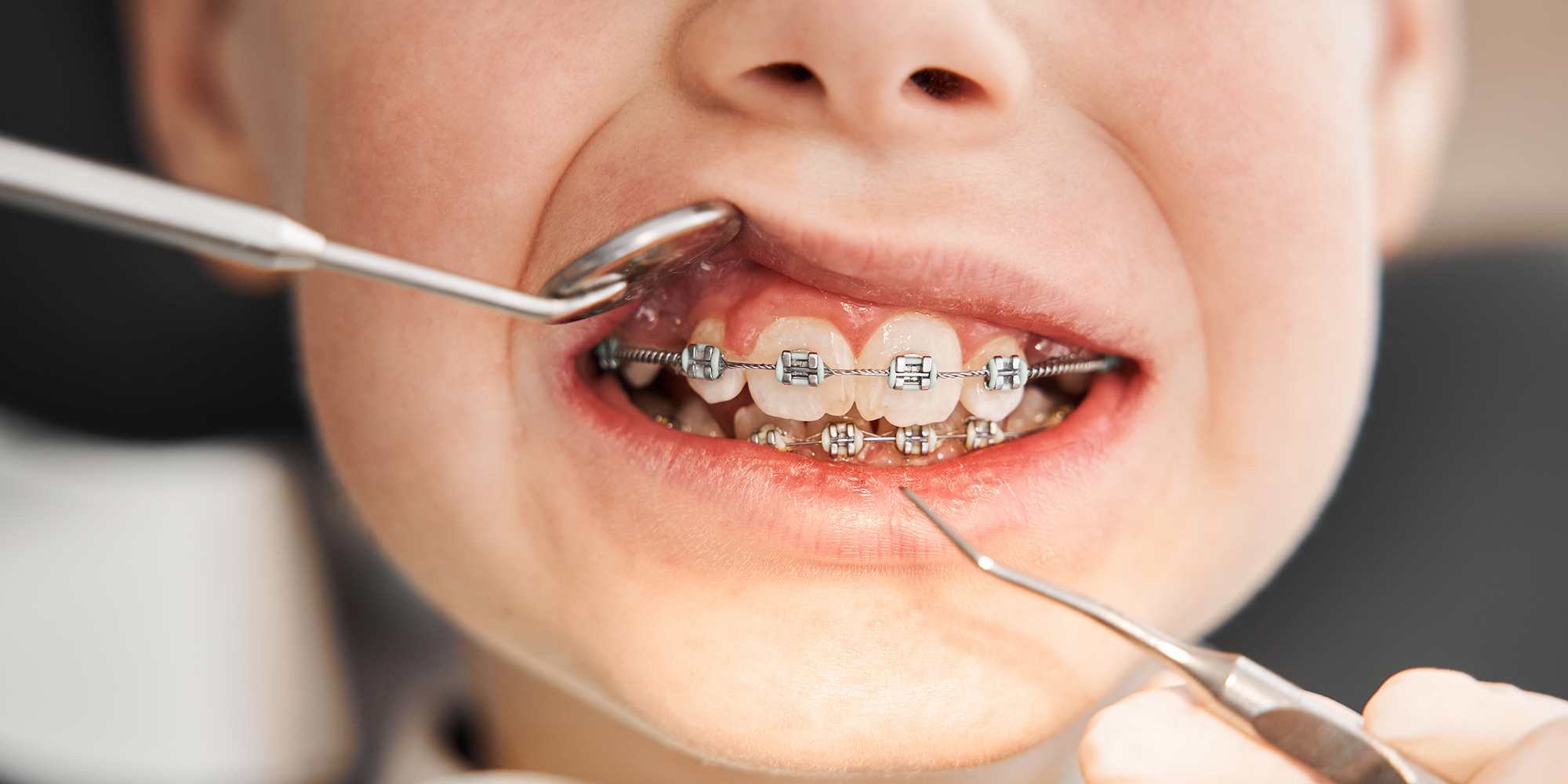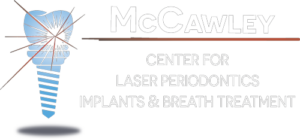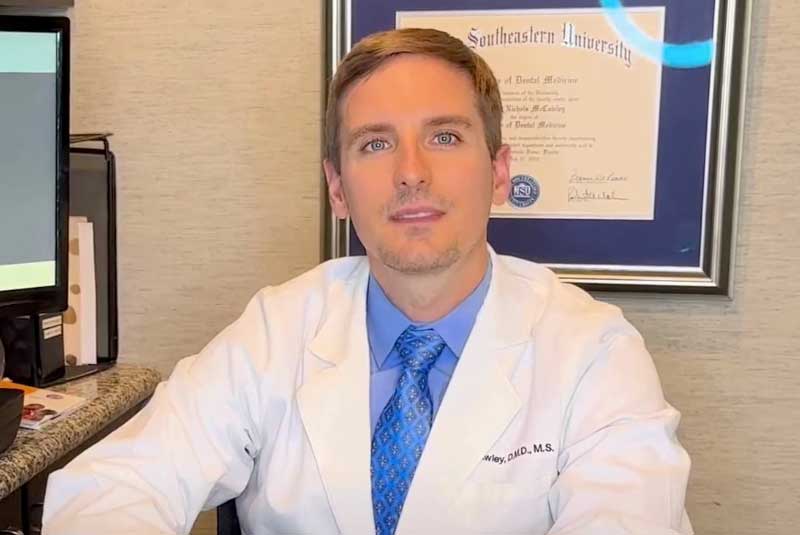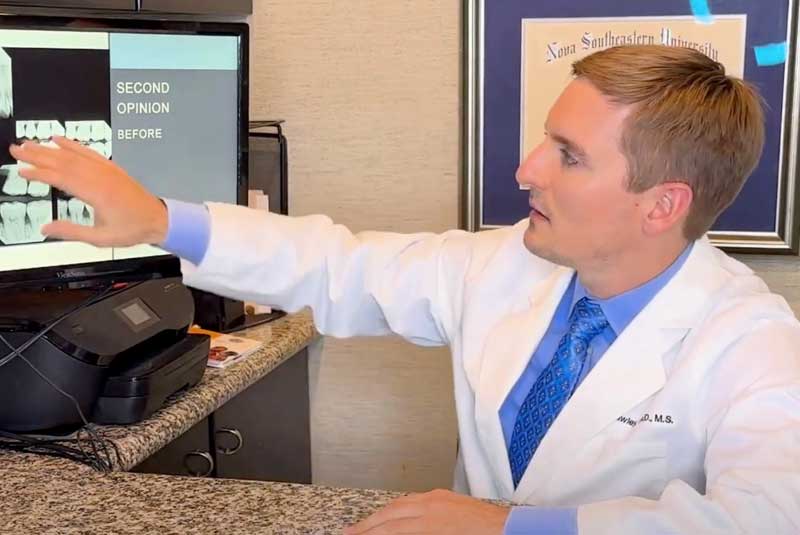| ✅ Reviewed by Dr. Tom McCawley | 🕒 Reading time: three minutes |
If you are considering braces or Invisalign, or are already in treatment, it’s important to understand how orthodontics can sometimes go wrong and what you can do to protect your teeth and gums.
At the McCawley Center for Laser Periodontics & Implants, we frequently see patients with gum or bone complications that started with orthodontic treatment. The good news? Many of these issues are preventable with the right care and planning.
Common Orthodontic Complications We See
Orthodontics works by applying controlled pressure to move teeth into better alignment. But without proper monitoring, this movement can sometimes lead to serious gum and bone damage.
1. Gum Recession From Tooth Movement
When braces or aligners push teeth too far outside the bone—especially the lower front teeth—it can lead to gum recession. This is more likely in people who naturally have thin gum tissue or limited bone support.
What gum recession looks like:
- Uneven gumlines
- Sensitive tooth roots
- Teeth that appear longer than normal
Once the gums recede, they don’t grow back. And if left untreated, this can lead to root exposure, cavities, and even tooth loss.
2. Bone Loss in Patients With Undiagnosed Gum Disease
Orthodontics relies on healthy bone to function properly. When your gums are healthy, bone is removed on one side of the tooth and rebuilt on the other as it shifts. But if you have active gum disease—even if it’s mild—you may lose bone without getting it back.
“If you have gum disease, the tooth will move, the bone will resorb, but it won’t regrow. That can lead to major tooth loss—fast.”
—Dr. Mark McCawley
That’s why we always recommend a periodontal screening before starting any orthodontic treatment.
Warning Signs Something Isn’t Right
Orthodontic issues don’t always show up right away. Be alert for early symptoms like:
- Receding gums
- Bleeding when brushing
- Sensitive or loose teeth
- Soreness or changes in bite
If you notice any of these changes during orthodontic treatment, it’s time to pause and get evaluated by a periodontist.
Watch:
How to Prevent Orthodontic Complications
The key to safe orthodontic care is prevention. Here’s what you can do:
Get a Gum Health Check First
Before you begin orthodontic treatment, ask your dentist or periodontist to check for gum disease or bone loss.
Don’t Skip Cleanings
Routine dental cleanings are essential during orthodontic treatment. Braces and aligners can trap food and plaque, increasing your risk for gum inflammation.
Monitor Thin Gum Areas
If your gums are naturally thin, your periodontist may recommend a gum graft before or during treatment to protect against recession.
Keep Communication Open
Make sure your orthodontist and periodontist are working together. Coordinated care leads to better outcomes and fewer surprises.
Can These Problems Be Reversed?
Many orthodontic complications can be stabilized or improved when addressed early. At our Fort Lauderdale office, we provide:
- Gum grafting to stop recession, protect the bone and save the tooth.
- Pinhole Surgical Technique™ to restore lost gum tissue comfortably, without grafts or stitches.
- Laser therapy (LANAP®) to treat gum disease and stimulate growth of bone and tissues.
If you are worried about your gum health during orthodontic treatment, we can help you understand your options and prevent long-term damage.
Book a Periodontal Screening in Fort Lauderdale, FL
If you are planning orthodontic treatment or noticing changes in your gums, early evaluation can make all the difference. Our team offers clear answers, advanced care, and minimally invasive options to help you keep your teeth and gums healthy.
To book an appointment at our periodontal office in Fort Lauderdale, FL, call (954) 807-4829 or visit us at 800 East Broward Blvd #706 Fort Lauderdale, FL.
Frequently Asked Questions
Moving teeth in the presence of gum disease can lead to rapid and irreversible bone loss. Always get a periodontal screening before starting orthodontic treatment to make sure your gums are healthy.
What are the warning signs something is wrong during orthodontic treatment?
Some of the most common warning signs include bleeding gums, receding gumlines, tooth sensitivity, or teeth that feel unusually loose. If you notice any of these changes, it is important to let your orthodontist know.
Mild recession can sometimes stabilize, but in many cases, a gum graft is needed to restore the tissue. The earlier it’s treated, the better the outcome.
Start by getting a comprehensive gum health check with your dentist or a periodontist before beginning orthodontic treatment. Throughout treatment, maintain excellent oral hygiene, keep up with all recommended dental cleanings, and make sure your dentist and orthodontist are sharing information as needed. If you notice any signs of gum disease, such as bleeding or swelling, have them evaluated and treated promptly to avoid further problems.
Clear aligners can contribute to gum recession or bone loss if tooth movement is not carefully planned and monitored. Although aligners make it easier to maintain good oral hygiene compared to braces, they still apply steady pressure to shift teeth, which can affect the surrounding tissues. Staying consistent with checkups and promptly addressing any gum changes are key to minimizing risks during aligner treatment.






